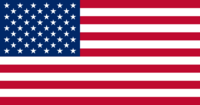United States of America: Difference between revisions
imported>Martin Baldwin-Edwards |
imported>John Stephenson (victories -> Allied victories - original made it sound like only the US fought in the wars; wiki linking) |
||
| Line 4: | Line 4: | ||
== History == | == History == | ||
Thirteen of [[Britain]]'s American colonies broke with the mother country in 1776 and were recognized as the new nation of the United States of America following the Treaty of Paris in 1783. During the 19th and 20th centuries, 37 new states were added to the original 13 as the nation expanded across the North American continent and acquired a number of overseas possessions. The two most traumatic experiences in the nation's history were the Civil War (1861-65) and the Great Depression of the 1930s. Buoyed by Allied victories in [[World War I|World Wars I]] and [[World War II|II]] and the end of the Cold War in 1991, the U.S. remains the world's most powerful nation-state. The economy is marked by steady growth, low unemployment and inflation, rapid advances in technology, and a very wide range of incomes, compared to other nation-states.<ref>[https://www.cia.gov/cia/publications/factbook/fields/2172.html CIA's World Factbook - Distribution of family income]</ref>[http://hdr.undp.org/hdr2006/pdfs/report/HDR06-complete.pdf#page=335] | |||
Thirteen of [[Britain]]'s American colonies broke with the mother country in 1776 and were recognized as the new nation of the United States of America following the Treaty of Paris in 1783. During the 19th and 20th centuries, 37 new states were added to the original 13 as the nation expanded across the North American continent and acquired a number of overseas possessions. The two most traumatic experiences in the nation's history were the Civil War (1861-65) and the Great Depression of the 1930s. Buoyed by victories in World Wars I and II and the end of the Cold War in 1991, the U.S. remains the world's most powerful nation-state. The economy is marked by steady growth, low unemployment and inflation, rapid advances in technology, and a very wide range of incomes, compared to other nation-states.<ref>[https://www.cia.gov/cia/publications/factbook/fields/2172.html CIA's World Factbook - Distribution of family income]</ref>[http://hdr.undp.org/hdr2006/pdfs/report/HDR06-complete.pdf#page=335] | |||
== See also == | == See also == | ||
Revision as of 05:40, 11 June 2007
The United States of America, also known as the United States or America, is a nation located in North America, bordering both the North Atlantic Ocean and the North Pacific Ocean, between Canada and Mexico.
History
Thirteen of Britain's American colonies broke with the mother country in 1776 and were recognized as the new nation of the United States of America following the Treaty of Paris in 1783. During the 19th and 20th centuries, 37 new states were added to the original 13 as the nation expanded across the North American continent and acquired a number of overseas possessions. The two most traumatic experiences in the nation's history were the Civil War (1861-65) and the Great Depression of the 1930s. Buoyed by Allied victories in World Wars I and II and the end of the Cold War in 1991, the U.S. remains the world's most powerful nation-state. The economy is marked by steady growth, low unemployment and inflation, rapid advances in technology, and a very wide range of incomes, compared to other nation-states.[1][1]
